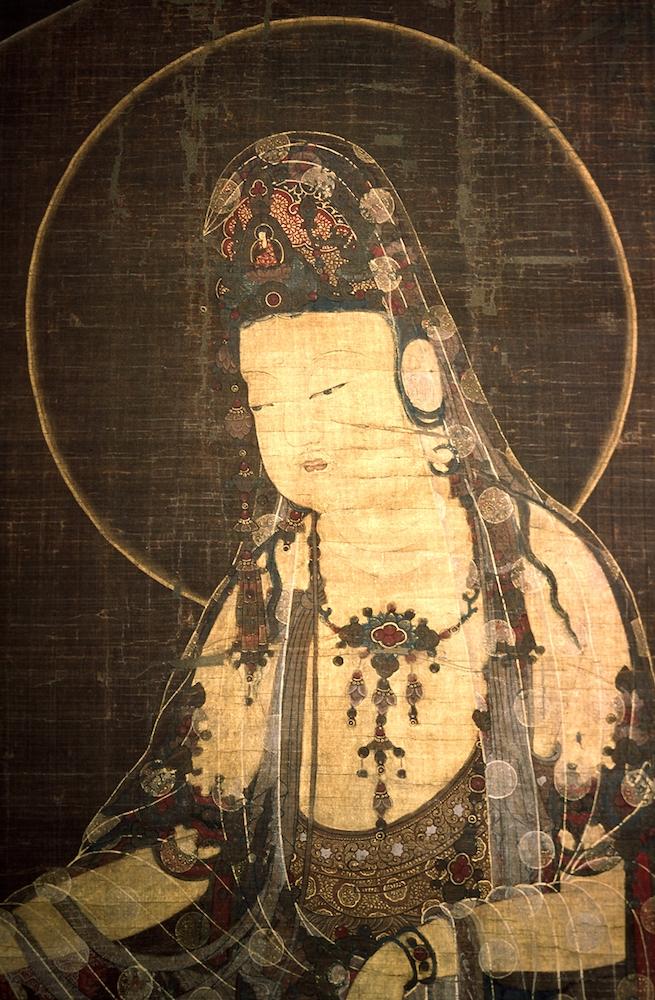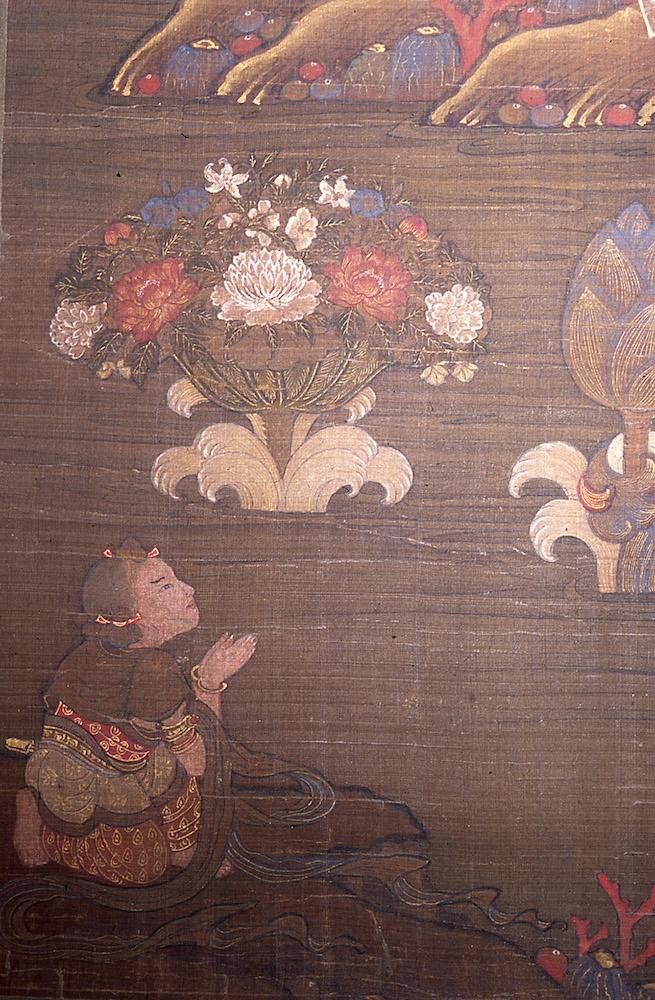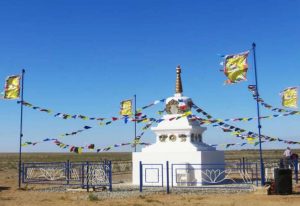Formalistic characteristics of Goryeo Water-moon Avalokiteshvara paintings
This article explores the authentic beauty and iconographical meaning of the Water-moon Avalokiteshvara paintings of the Korean Goryeo dynasty (918–1392). Paintings of Water-Moon Avalokiteshvara (水月觀音圖) were in fact quite popular in the Buddhist tradition not only in Goryeo Korea, but throughout East Asia, including in China and Japan. Extant paintings thus exhibit a variety of styles and forms, with the Goryeo Water-moon Avalokiteshvara paintings preserving the oldest form, whose origin can be traced to Tang dynasty (618–907) China.
In the typical Goryeo form, the bodhisattva of compassion Avalokiteshvara is seated in half-lotus posture and presents a three-quarter side view, looking down at his acolyte, the boy Sudhana, at his feet. Here, he is seated comfortably on the diamond rock seat with the right leg resting on the left knee, his body shining like the full moon against a circular aureole and draped in a highly sophisticated, diaphanous white veil called a sara (紗羅). Regular elements include Sudhana, bamboo, a kundika (bottle containing purified water) with a willow branch, and a pond. Although variations can be found, these traits can be considered the main characteristics of Water-moon Avalokiteshvara paintings from Goryeo dynasty Korea.
Unfortunately, the original stylistic details cannot be verified as there are no surviving works from the area of the Tang dynasty capital, Chang’an (today’s Xi’an in Shaanxi Province), which would have served as a model for the paintings, although a few paintings of Water-moon Avalokiteshvara discovered in the region of Dunhuang in northwest China do give us some indication of their appearance. However, it can be argued that the soft yet luxurious, elegant yet solemn, aristocratic stylistic characteristics realized by the Tang artist Zhou Fang (c. 730–800) were transmitted to Korea in the Silla period (57 BCE–935 CE) and perfected in the Water-moon Avalokiteshvara depictions of the Goryeo.
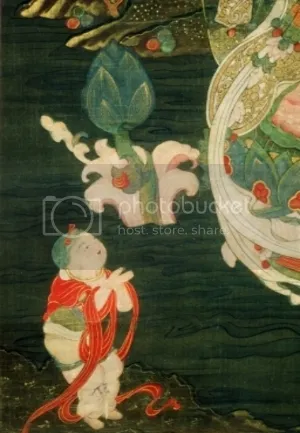
Body of the Full Moon (滿月之體), Light of the Full Moon (滿月之光)The Goryeo dynasty Water-moon Avalokiteshvara paintings impart a deep, mystical atmosphere befitting the lyricism of the name “water-moon.” Representative characteristics are the gentle, round face and plump body, the sara covering the whole figure, the highly elaborate ornamental pendants, the robes decorated with beautifully delicate patterns, and the rock seat painted in gold and green. The major characteristic, however, is the divine luminescence, round like the full moon, enveloping the entire form. This aureole, giving form to the light emanating from the bodhisattva, conveys a sense of the full moon illuminating the dark night sky. The figure of Avalokiteshvara is revealed in the gently shining light of his “compassion,” as pure and gentle as the light of the moon.
The distinguishing characteristics of the painting lead to the conclusion that the nature of Avalokiteshvara is expressed by the moon and the moonlight. They can be interpreted as representing the “light of compassion” coming from Avalokiteshvara, who indeed is considered the embodiment of compassion. This gives rise to the questions: What is “the wonderful activity of the great light of compassion” (大悲法門光明之行) realized by Avalokiteshvara, and what is its function?

Utterances on how to save suffering sentient beings can be found in the chapter “Entry into the Dharma Realm” (入法界品) (Skt. Gandhavyuha) from the Avatamsaka Sutra, in the section where Sudhana encounters Avalokiteshvara. Here, the bodhisattva teaches the ways of enlightening and embracing all kinds of beings with a net of light: “I save sentient beings from suffering with a great net of light” (放大光網 除滅眾生諸煩惱熱). And as seen in a recitational verse in praise of Avalokiteshvara:
“I, the brave Avalokiteshvara
Arouse great compassion so deep and pure
Like a net of clouds I radiate the great wondrous light
As vast as the air and pristine beyond compare”
(我是勇猛觀自在 起深清淨大慈悲 普放雲網妙光明 廣博如空極清淨)

willow branch
The shining body of Avalokiteshvara and the dazzling veil can thus be interpreted as visual manifestations of the net of light. The function of the “pure light of great compassion” (清淨大慈悲光明), like the light of the full moon, is to clear away the darkness of suffering of all sentient beings.
The meaning hidden in the name “water-moon” (水月)
What is the relationship between the bodhisattva Avalokiteshvara and the “water-moon” (水月), or “the moon reflected in the water” (水中月) (Skt. udakachandra)? What is the ideological background to the iconography of the paintings, and what symbolism contained in it gave it such great popularity through the Chinese Tang, Song (960–1279), and Yuan (1271–1368) dynasties as well as the Goryeo and Joseon (1392–1897) dynasties of Korea?
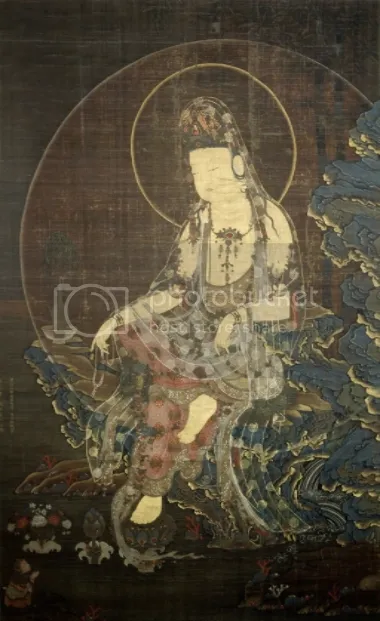
dynasty, 1323, ink and color on silk. Senoku Hakuko kan,
Kyoto, Japan. Image courtesy of the author
The various iconographical elements appearing in Water-moon Avalokiteshvara paintings are all rooted in the keyword parishuddhi (清淨), or “purity.” The kundika with willow spray, the clear stream water, and the young boy Sudhana can all be seen as symbols of purity, and the purity of the light of compassion emanating from Avalokiteshvara clears away all the sufferings of sentient beings. The purifying water verse from the Sangjuwongong (常住勸供), a Buddhist rite for the dead, describes Avalokiteshvara as the great healer of sentient beings:
“Avalokiteshvara is the great healer for he cures all illnesses
The scent of pure Dharma water in the kundika is so sweet
Chasing away clouds of evil spirits and raising the holy spirit
Extinguishing burning anguish and regaining parishuddhi (purity)”
(觀音菩薩大醫王 甘露甁中法水香 灑濯魔雲生瑞氣 消除熱惱獲淸凉).
This verse indicates that the function of Avalokiteshvara’s kundika is to hold the Dharma water which is purified by the willow spray, revealing the pure, true nature of sentient beings. The concept of parishuddhi mentioned above is fundamentally related to the “pure dharma-body” (淸淨法身) (Skt. parishuddhi dharmakaya), a term also used to designate the Buddha Vairochana.
“The bodhisattva is like the bright sun and moon
A bright white mirror appears suspended in the sky
The shadow of the moon reflects in countless rivers
But the entity in the heavens does not mix with the water
Thus are the pure teachings of the bodhisattva
He appears in the water of the minds of all beings
But does not mix with the world.”
(譬如淨日月 皎鏡在虛空 影現於衆水 不爲水所雜 菩薩淨法輪 當知亦如是 現世間心水 不爲世所雜)
This quote is from the chapter “Detachment from the World” (離世間品) in the Avatamsaka Sutra, which goes into great detail about reaching the level of the bodhisattvas and again likens the principle of the incarnation body to the pure light of the moon. Just as one moon is reflected in countless rivers to reveal its image, the bodhisattva appears in the minds of countless beings. The light of wisdom and compassion is said to clear away suffering and pain and dry up the sea of lust.
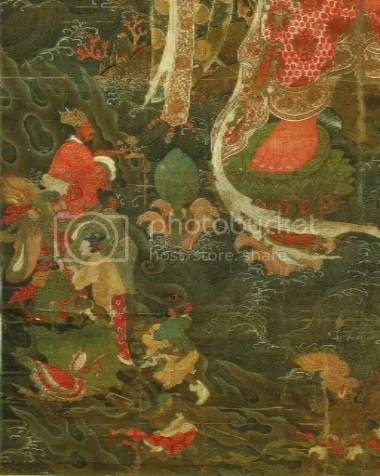
dynasty (918–1392), ink and color on silk. Daitoku-ji,
Kyoto, Japan. Detail showing the Dragon King and Queen
paying homage to Avalokiteshvara
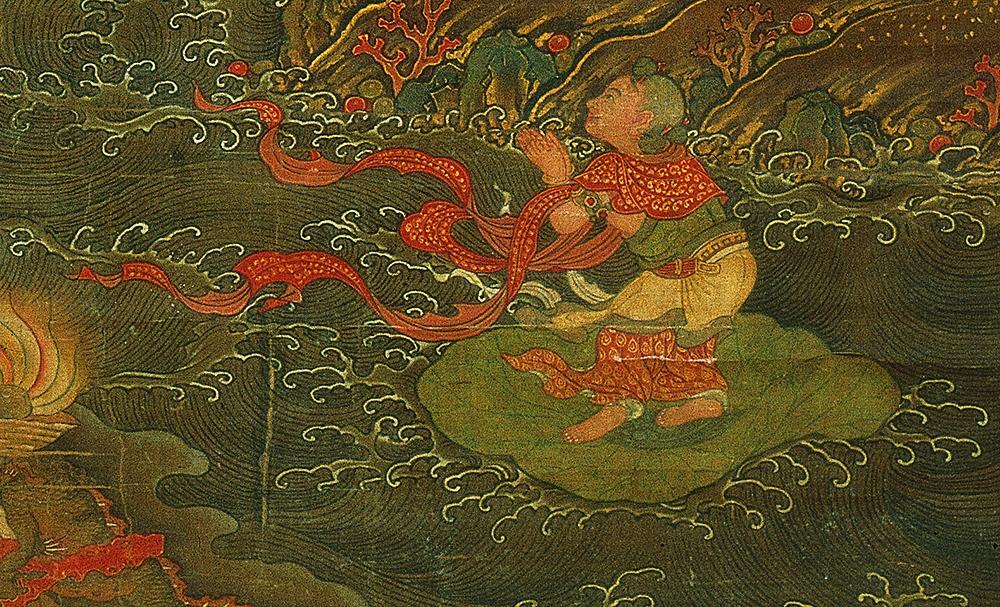
While the scriptural source for the iconography of Water-moon Avalokiteshvara is the scene of Sudhana’s meeting with Avalokiteshvara in “Entry into the Dharma Realm,” the paintings are not reflections just of that limited scene but of “the bodhisattva as incarnation body,” which is the main concept running through the Avatamsaka Sutra as a whole. The “relationship between the dharma-body [Skt. dharmakaya] and incarnation body [Skt. nirmanakaya]” mentioned in the sutra is frequently compared to the “water-moon” or “the moon reflected in the water.” Avalokiteshvara’s manifestation according to the nature and needs of sentient beings and as an embodiment of purity and compassion are concepts central to the name “Water-moon Avalokiteshvara.”
Soyon Kang is an associate professor at Hongik University in Seoul, specializing in Korean Buddhist art.



